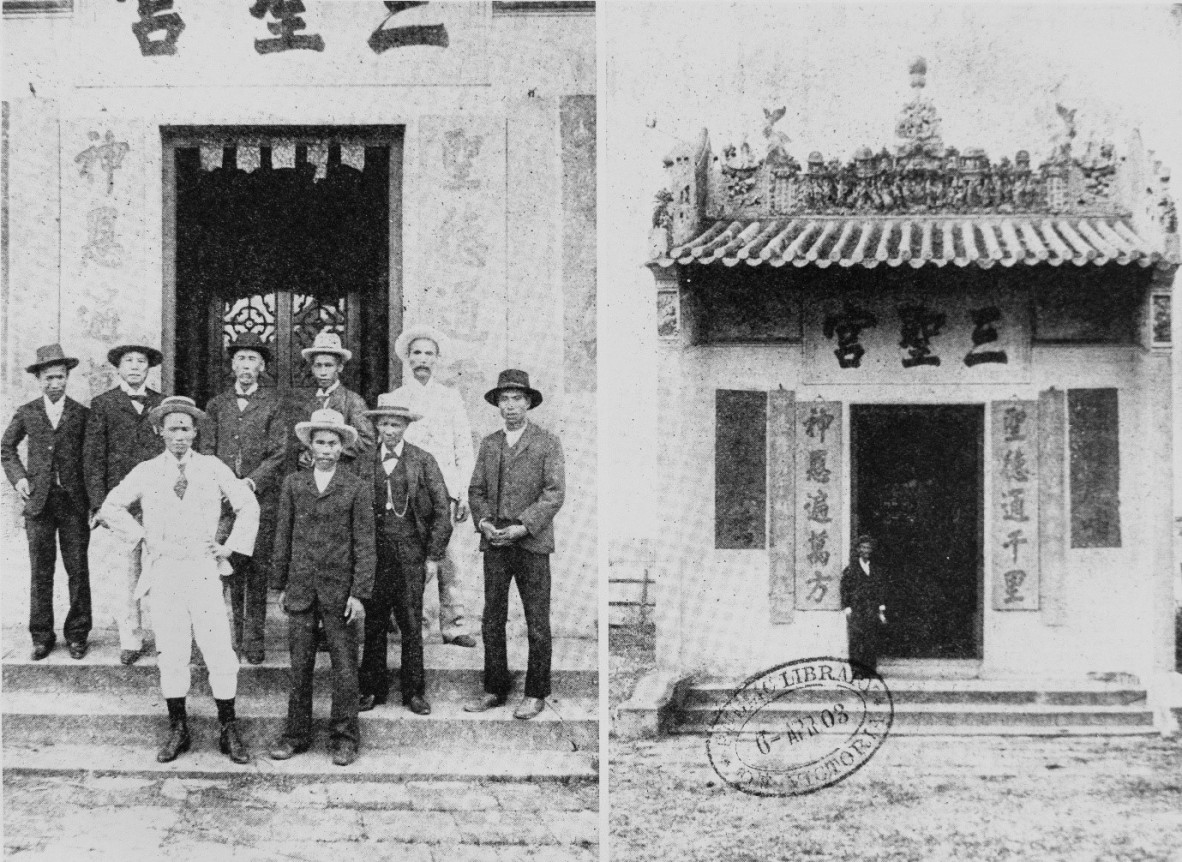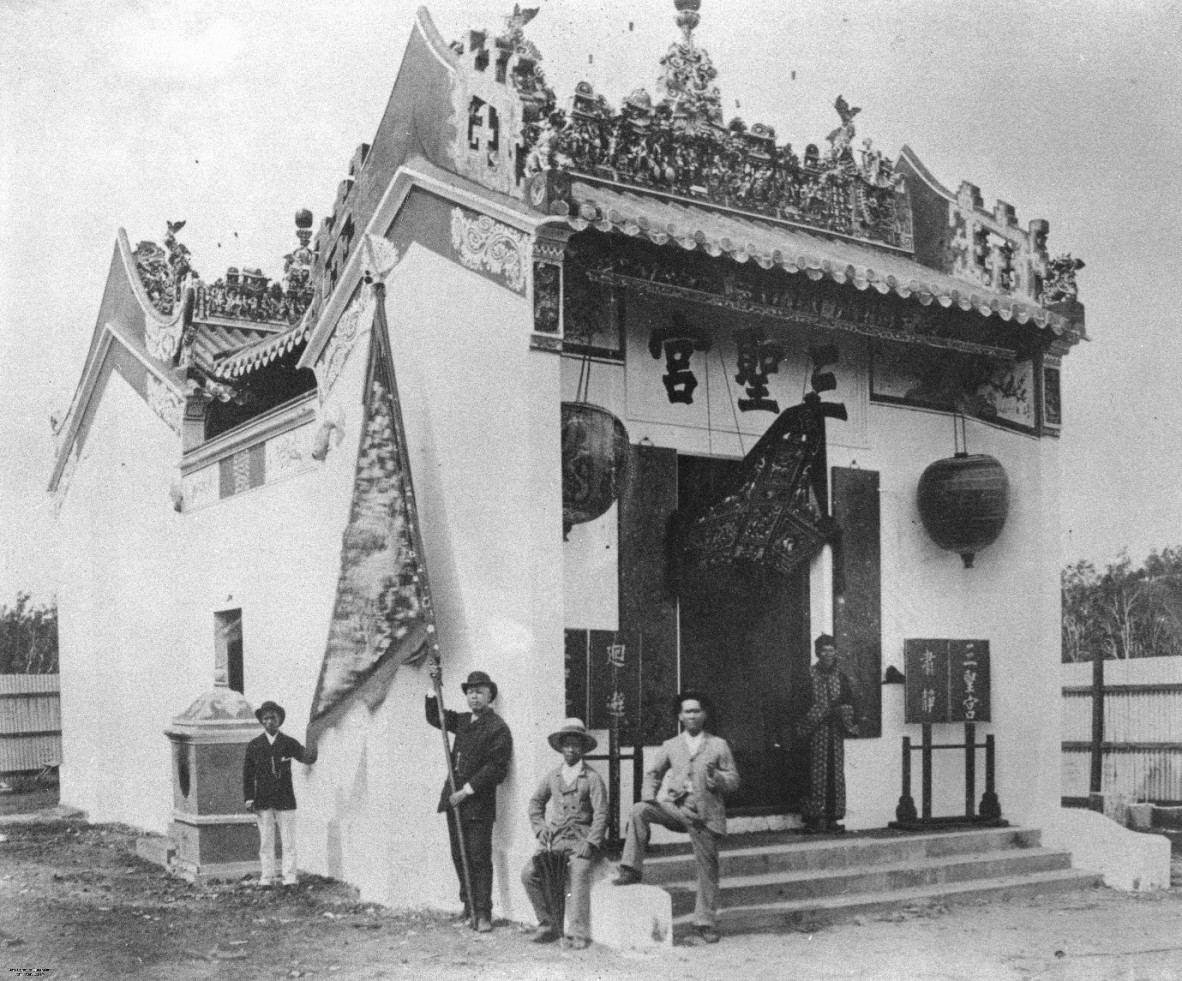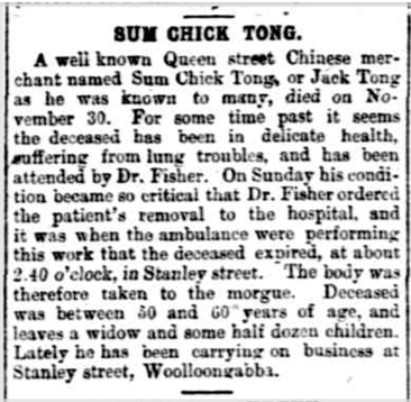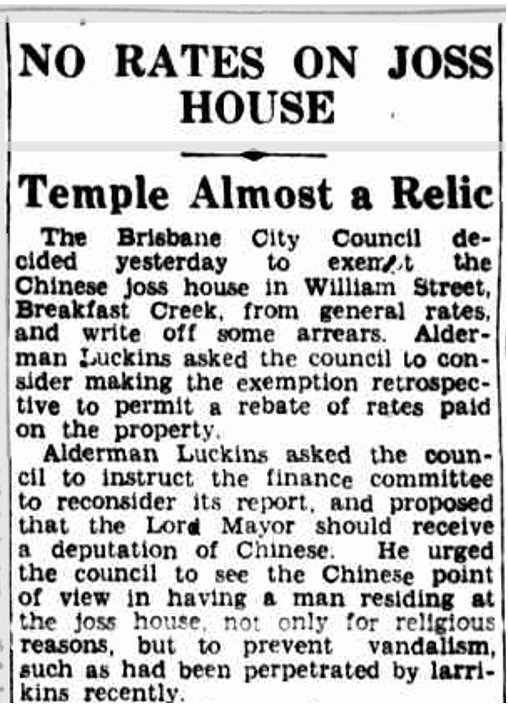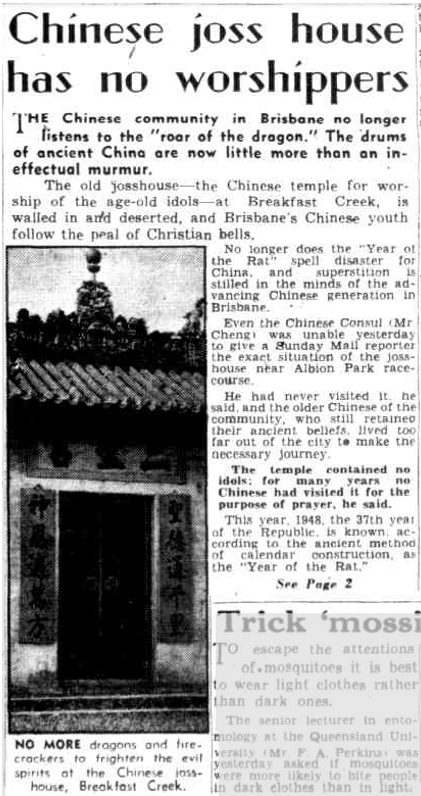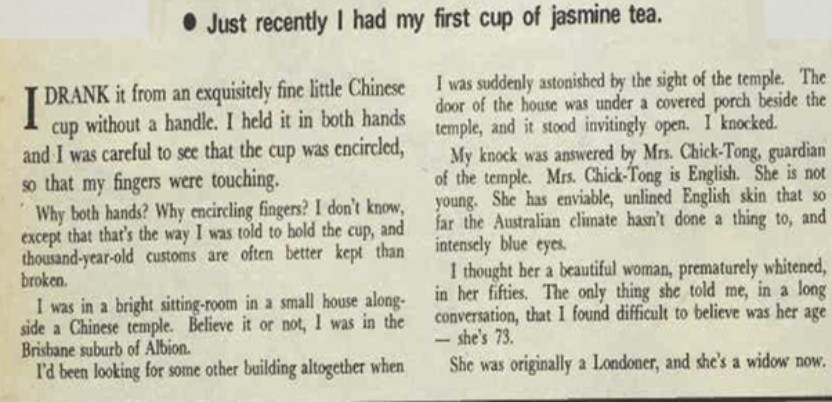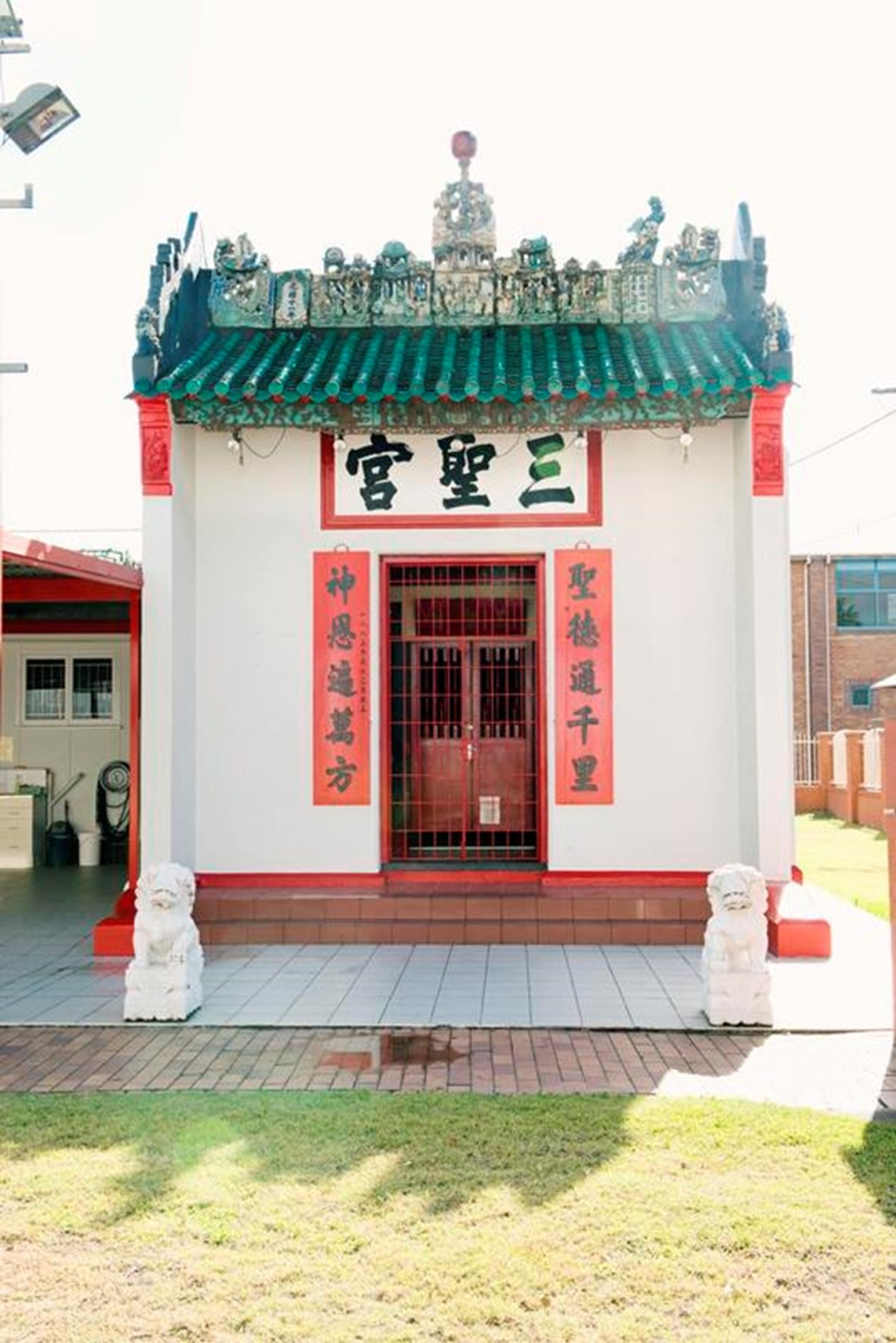A quaint temple at Breakfast Creek: The Temple of the Holy Triad and the Temple Guardian
By Christina Ealing-Godbold, Research Librarian, Library and Client Services | 10 May 2024
Standing as a testament to Brisbane’s early Cantonese Chinese Community, the Temple of the Holy Triad at Breakfast Creek (known as Joss House) was built in 1886. To the Chinese community, it was known as Sarm Sung Goon. It was opened with great fanfare, dragon dances and processions. Located at 32 Higgs Street, Albion the temple is between the Breakfast Creek Hotel and the Albion Park Racecourse. The location was chosen because many of the Chinese people had market gardens in the Breakfast Creek area. Cantonese Chinese in Brisbane were drawn from five different clans in the delta region of Southern China and the temple was seen as a way of uniting the Brisbane Chinese community.
One of the original trustees of the temple, Sum Chick Tong was a well- known merchant in Brisbane. His firm, Kwong Nam Tai and Co imported much of the roofing material for the complex triple roof, as well as tiles and ornamentation used on the temple. It is reported that Sum Chick Tong led the procession at the opening of the temple. It was during a period of Anti-Chinese sentiment in the Brisbane community and in 1888, just two years after the temple was opened, the Anti-Chinese riots broke out in Albert Street in Brisbane, causing a loss of trade. As a result many of the Chinese merchants were declared insolvent. Sum Chick Tong lost his business but continued to work as a grocer. Married and the father of a number of children including Thomas, William, George, Lena, Daisy and Violet, Sum Chick Tong died in 1902 of tuberculosis.
Despite the efforts of the early temple trustees, by the 1930s The Temple of the Holy Triad was seen as a “quaint” reminder of earlier times and only a few older citizens used it as a place of worship. The Sunday Mail on 11th February 1934 noted that:
The old Joss-house, with its quaint, weird and mysterious wood carvings and painted porcelain tilings, its rich silken tapestries and inscrutable idols, still stands a colourful relic of old China.
In 1935, the Brisbane City Council waived the rates bill as it appears that there was nobody left to pay them – the original trustees had all died or returned to China or Hong Kong. By 1948, it had no worshippers at all and was considered a relic of an earlier era.
As a result of the temple’s abandonment and decline and fearing demolition in 1964, a new governing arrangement came into force. The Queensland Parliament passed the Chinese Temple Society Act of 1964 and in 1965, restoration of the temple began. It was reopened in June 1966.
The Chinese Museum of Queensland have the following information on their website:
To avoid the temple's demolition, the Chinese Club were invited to consider the temple's condition and make recommendations. The Chinese Temple Society was formed and lobbied the Queensland Government successfully for the temple's restoration and ongoing purpose as a place of worship. Restoration commenced in 1965, including retrieving and replacing the stolen and vandalised original movable objects. The temple reopened in 1966. A new caretaker's residence was added to the western side of the temple, and in the 1970s, a new Buddhist temple was added on the western side of the caretaker's residence.
A temple guardian: Mrs Dorothy Chick Tong
As part of the restoration of the temple, it was agreed upon that a caretaker should be appointed and the construction of a caretaker’s premises to the side of the temple was undertaken. During the decades from 1968 to 1988, the temple was looked after by an English woman. Mrs Dorothy Chick Tong, the Caretaker, was the wife of George Chick Tong, the son of the original trustee, Sum Chick Tong.
George Chick-Tong (known as Gum Wing Chick-Tong) lived at Enoggera Terrace, Red Hill and died in 1968. His second wife and widow, Mrs Dorothy Chick Tong was interviewed by the Australian Women’s Weekly in 1972 and her story was published in the “At Home” section on the 26th April 1972.
Born Dorothy Gladys Penn in Kent, Dorothy arrived in Queensland in 1959.
Dorothy Gladys Hopkins (nee Penn) become the second Mrs George Chick-Tong, at Paddington, Brisbane in 1964. After the death of her husband, Dorothy did indeed become the caretaker of the temple in Higgs Street, Albion. The electoral rolls list her as living there and her occupation is given as "caretaker".
In her enthusiasm to look after the temple, Dorothy cleaned up the large brass vessels that held the joss sticks and put them back in the wrong place as she couldn’t understand the Chinese inscriptions. However, she had soon learnt the story of the decorations in the temple and according to the Australian Women’s Weekly, Dorothy could point them out and tell the story of each one.
Some current Brisbane residents remember conversations with the friendly Mrs Chick Tong, Temple Guardian and have remarked on the English woman who cared for the spiritual interests of the Chinese in Breakfast Creek. Dorothy Chick Tong died in 1991 (she would have been 90 years of age).
Dorothy’s service to the Chinese community in Brisbane over a period of more than twenty years, looking after the temple and welcoming visitors, provides an excellent example of respect for cultural heritage, regardless of faith or background.
Today the Temple of the Holy Triad still welcomes visitors and worshippers on festival days. The temple was listed on the Queensland Heritage Register in 1992 and is one of only three surviving Chinese temples in Queensland.
Further reading
More information
One Search catalogue – https://onesearch.slq.qld.gov.auopen_in_new
Library membership – https://www.slq.qld.gov.au/services/membership
Ask a librarian - https://www.slq.qld.gov.au/services/ask-librarian
Plan your visit – https://www.slq.qld.gov.au/visit
Comments
Your email address will not be published.
We welcome relevant, respectful comments.
